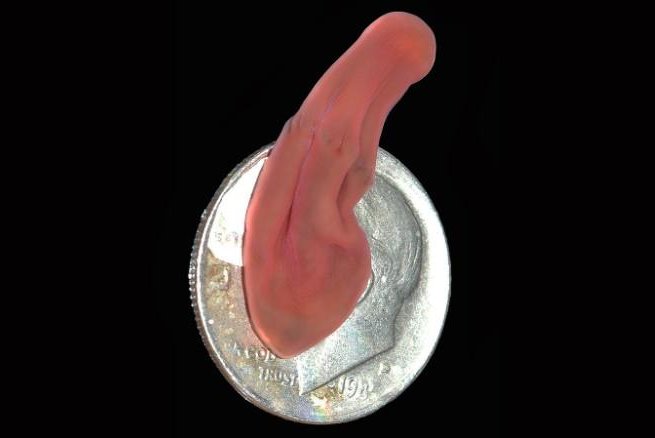One of the newly discovered sea sock species lies atop a U.S. dime. Photo by Western Australian Museum/Scripps Institution of Oceanography/Monterey Bay Aquarium & Research Institute
PERTH, Australia, Feb. 4 (UPI) -- Scientists in Australia have found four new deep-sea worm-like species in the Pacific.
They belong to the genus Xenoturbella and look like empty socks -- which is why one of the species has been dubbed "purple sock." Scientists say the strange and antiquated creatures offer clues as to what early life on Earth looked like and how it evolved.
The almost-worms were captured in the Pacific Ocean off the coasts of California and Mexico using remotely operated submersibles. The four species -- Xenoturbella monstrosa, Xenoturbella hollandorum, Xenoturbella profunda and Xenoturbella churro -- are described in a new paper published this week in the journal Nature. Xenoturbella monstrosa is the purple sock.
First discovered in 1949, scientists have been utterly confused by the sock-like animals. They are incredibly simple; their limp bodies host no brain, gills, eyes or reproductive organs, just one hole for food to go in and waste to go out.
Researchers knew it ate mollusks, but that was about it. For a brief period, scientists thought it was a mollusk of sorts after finding mollusk DNA inside the deep-sea creature.
"It was first described as a flatworm, and then confused with molluscs for a while. Increasingly sophisticated DNA analyses placed them as closely related to Deuterostomes (which include sea urchins, sea squirts, and humans), or to being closely related to Acoel worms," lead study author Nerida Wilson, a senior research scientist at the Western Australian Museum, explained in a news release.
Previously, scientists thought Xenoturbellas evolved from more complex organisms, reverting to simpler strategies for survival. But the discovery of four new species has helped reposition the group on the tree of life and the evolutionary timeline -- confirming that the worm-like creatures were always this basic.
"Our results confirm that Xenoturbella are closely related to Acoels, and that together these are the sister group to both Deuterostomes and Protostomes, which include arthropods, molluscs and annelids," Wilson added. "This means that the basic body features they have were always simple, and not secondarily simplified over time. This helps us interpret how complex features evolve."















